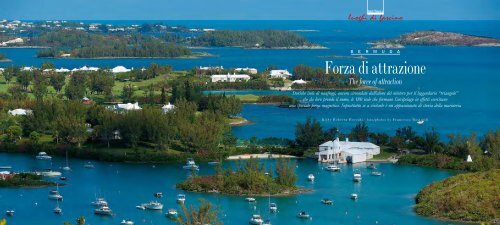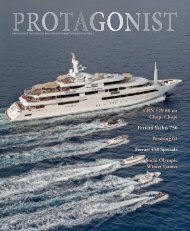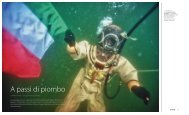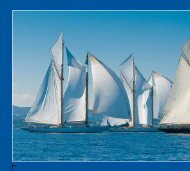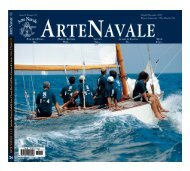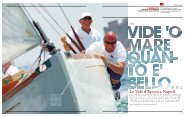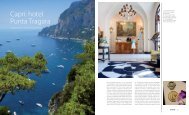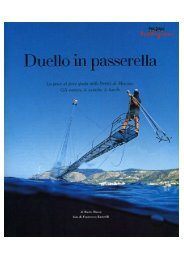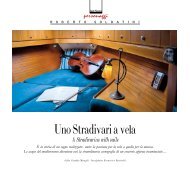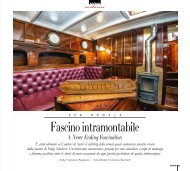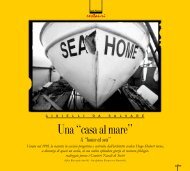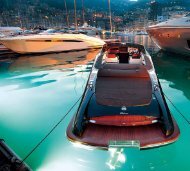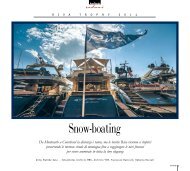You also want an ePaper? Increase the reach of your titles
YUMPU automatically turns print PDFs into web optimized ePapers that Google loves.
Arte Navale<br />
luoghi di fascino<br />
b e r m u d a<br />
Forza di attrazione<br />
The force of attraction<br />
Storiche isole di naufragi, ancora circondate dall’alone del mistero per il leggendario “triangolo”<br />
che da loro prende il nome, le 180 isole che formano l’arcipelago in effetti esercitano<br />
una speciale forza magnetica. Soprattutto se a visitarle è un appassionato di storia della marineria<br />
D i / b y R o b e r t a R o c c at i - fo t o /p h o t o s b y F r a n c e s c o R a s t r e l l i
certezza, scientificamente<br />
incontrovertibile, tra le tante<br />
L’unica<br />
leggende sulla scomparsa di<br />
aerei e navi nel cosiddetto Triangolo delle<br />
<strong>Bermuda</strong> (805 Km 2 di Oceano Atlantico<br />
racchiusi tra la punta della Florida, la città<br />
di San Juan a Portorico e <strong>Bermuda</strong>) è che<br />
dopo un soggiorno, si sente davvero una<br />
forza d’attrazione misteriosa verso i 181 isolotti,<br />
collegati tra loro, che formano questo<br />
incantevole arcipelago a forma di amo da<br />
pesca. 54 Km 2 di natura lussureggiante,<br />
architettura coloniale dai colori variopinti<br />
e spiagge color malva affacciate nel blu, le<br />
<strong>Bermuda</strong> sono a 650 km ESE dal North<br />
Carolina, lontano dai Caraibi, di cui erroneamente<br />
si pensa facciano parte.<br />
Il loro innato magnetismo colpì di certo Sir<br />
George Somers, ammiraglio inglese della<br />
Virginia Company al comando della Third<br />
Supply Relief Fleet. I nove vascelli partiti<br />
nel 1609 da Plymouth alla volta della<br />
Virginia per portare rifornimenti e nuovi<br />
emigranti nella neonata colonia americana<br />
di Jamestown approdarono a <strong>Bermuda</strong><br />
insieme ai 150 sopravvissuti al naufragio<br />
The only scientifically incontrovertible<br />
certainty of the many legends<br />
on the disappearance of planes and<br />
ships in the so-called <strong>Bermuda</strong> Triangle<br />
(8310 square miles of the Atlantic Ocean<br />
between the tip of Florida, San Juan in<br />
Puerto Rico and <strong>Bermuda</strong>) is that after<br />
staying in <strong>Bermuda</strong>, you really feel a mysterious<br />
force of attraction towards the 181<br />
linked islands, which form this delightful<br />
archipelago in the shape of a fish hook:<br />
20 square miles of luxuriant nature, multicolored<br />
colonial architecture and mauve<br />
beaches overlooking the blue sea, 403 miles<br />
ESE of North Carolina (and so a long way<br />
from the Caribbean, which it is mistakenly<br />
thought to belong to).<br />
Sir George Somers, a British admiral of<br />
the Virginia Company at the command of<br />
the Third Supply Relief Fleet (nine ships,<br />
which set sail from Plymouth in 1609 for<br />
Virginia to bring supplies and new immigrants<br />
to the newborn American colony<br />
of Jamestown) was probably possessed by<br />
the same feeling when he at last landed in<br />
<strong>Bermuda</strong>, together with the 150 survivors<br />
Qui sopra e nelle pagine<br />
precedenti: vedute<br />
dell’arcipelago bermudiano<br />
di origine vulcanica,<br />
circondato dalla barriera<br />
corallina e suddiviso in parrish<br />
(parrocchie), con capitale<br />
Hamilton. A destra: Fort St.<br />
Catherine domina la spiaggia<br />
che fu l’approdo della Sea<br />
Venture.<br />
Here, top and on the<br />
previous pages: views of<br />
the <strong>Bermuda</strong> archipelago,<br />
which is of volcanic origin,<br />
surrounded by a coral<br />
barrier reef and divided into<br />
parishes, with Hamilton as<br />
the capital. On the right: Fort<br />
St. Catherine dominates the<br />
beach where the Sea Venture<br />
landed.<br />
116 117
Nella pagina a lato: la bandiera su Fort<br />
Hamilton, una lapide nei Royal Naval<br />
Dockyards, lo stemma di un club di<br />
pescatori d’altura, la variopinta architettura<br />
bermudiana. Qui a sinistra: bandiera del<br />
Royal Hamilton Amateur Dinghy Club, la<br />
facciata della Cattedrale, un’accurata rosa<br />
dei venti.<br />
On the facing page: the flag flying on Fort<br />
Hamilton, a memorial plaque in the Royal<br />
Naval Dockyards, the coat of arms of a<br />
deep sea fishing club, the multi-colored<br />
architecture of <strong>Bermuda</strong>. Here on the left:<br />
the flag of the Royal Hamilton Amateur<br />
Dinghy Club, the façade of the Cathedral, a<br />
detailed wind rose.<br />
della nave ammiraglia Sea Venture al largo<br />
di Discovery Bay.<br />
A dare il nome all’arcipelago era stato Juan<br />
de Bermudez, esploratore spagnolo che nel<br />
1503 per primo approdò sull’isola maggiore<br />
e da cui subito ripartì, trovando infida<br />
la barriera corallina circostante. Somers<br />
invece si fermò a lungo per costruire due<br />
nuovi vascelli, il Deliverance e il Patience<br />
(realizzati sfruttando l’ottimo legno di<br />
cedro bermudiano e l’alberatura recuperata<br />
dalla Sea Venture) con cui proseguì il<br />
viaggio verso la costa americana. Questa<br />
sosta prolungata pose le basi per l’insediamento<br />
della più antica colonia dell’impero<br />
britannico (ripopolata in seguito da schiavi<br />
d’Africa e indiani d’America) e per il successivo<br />
sviluppo della cantieristica navale<br />
e del commercio marittimo. Questo spesso<br />
fu esercitato ai confini della legalità dai<br />
privateers che sfruttavano i veloci sloop con<br />
il famoso “armo bermudiano”. Due condizioni<br />
che, insieme alla posizione geografica<br />
strategica, resero <strong>Bermuda</strong> l’avamposto<br />
britannico in Atlantico.<br />
of the wreck of the flagship Sea Venture<br />
off Discovery Bay. Its name came from his<br />
predecessor, Juan de Bermudez, a Spanish<br />
explorer who in 1503 was the first to land<br />
on the largest island and immediately departed,<br />
finding the surrounding coral reef<br />
treacherous. Somers, on the other hand,<br />
stayed there for a long time to build two new<br />
ships, the Deliverance and the Patience<br />
(taking advantage of the excellent <strong>Bermuda</strong><br />
cedar wood and the masting salvaged from<br />
the Sea Venture) with which he continued<br />
the voyage to the American coast. This<br />
prolonged stay laid the foundations for the<br />
settlement of the oldest colony of the British<br />
Empire (subsequently repopulated by slaves<br />
from Africa and native Americans) and for<br />
the subsequent development of the shipyards<br />
and seafaring trade, often exercised at the<br />
limits of legality by the privateers who took<br />
advantage of the fast sloops with the famous<br />
“<strong>Bermuda</strong> sloop”. These two conditions,<br />
together with the strategic geographical po-<br />
118 119
Per questo stretto legame con la Royal<br />
Navy, prima ancora che meta turistica d’eccellenza,<br />
le <strong>Bermuda</strong> sono state, e sono tuttora,<br />
depositarie di grandi tradizioni marittime.<br />
Per “respirarne l’aria”, non è neppure<br />
necessario (anche se consigliato) attrezzarsi<br />
con erogatore e bombole per immergersi<br />
tra più di 300 relitti sommersi a meno di 15<br />
metri di profondità (imperdibili le immersioni<br />
sul Cristobal Colon, sull’Hermes o sull’Herminie).<br />
Sarà sufficiente “essere” a <strong>Bermuda</strong><br />
dove i segni di un arcipelago votato alla<br />
marineria sono davvero tangibili: dalla<br />
replica della Deliverance in King’s Square<br />
a Town of St. George (primo insediamento<br />
inglese dichiarato patrimonio dell’Unesco)<br />
alle migliaia di imbarcazioni ormeggiate di<br />
fronte alle abitazioni. Dai mitici “bermuda”,<br />
simbolo e abito maschile nazionale, da<br />
portarsi secondo regole ferree perché introdotti<br />
dai marinai della Royal Navy, alle 24<br />
possenti fortezze (delle 90 originariamente<br />
costruite) che ancora dominano quelle che<br />
furono le postazioni di difesa di Spagnoli,<br />
Francesi, Americani e Russi. Fort Hamilton,<br />
completato nel 1870 su ordine del Duca di<br />
Wellington e Fort St. Catherine, sorto nel<br />
1614 sulla stessa spiaggia su cui approdarono<br />
i naufraghi delle Sea Venture, sono<br />
solo alcuni dei forti interamente edificati in<br />
pietra che offrono spunti di storia militare<br />
e marittima, insieme a scorci panoramici<br />
impagabili proiettati nel blu.<br />
La più grande fortificazione esistente, nonché<br />
“cuore navale” di <strong>Bermuda</strong>, è costituita<br />
dai Royal Naval Dockyards che occupano<br />
sition, made <strong>Bermuda</strong> the British outpost<br />
in the Atlantic.<br />
Due to this close link with the Royal Navy,<br />
before it became an excellent tourist destination,<br />
<strong>Bermuda</strong> was, and still is, a custodian<br />
of great seagoing traditions. To “breathe in<br />
its air”, you don’t even have to (although it<br />
is recommended) to strap on oxygen tanks<br />
to dive amidst the more than 300 wrecks<br />
lying at a depth of less than 50 feet (not<br />
to be missed are the Cristobal Colon, the<br />
Hermes or the Herminie). It will be enough<br />
to “be” in <strong>Bermuda</strong> where the signs of an<br />
archipelago devoted to sailing are really tangible:<br />
from the replica of the Deliverance<br />
in King’s Square to St. George’s Town<br />
(the first British settlement to be declared a<br />
UNESCO World Heritage site) to the thousands<br />
of boats moored facing the houses.<br />
From the mythical “bermudas”, the national<br />
symbol and male dress, to be worn according<br />
to hard and fast rules because they were<br />
introduced by the sailors of the Royal Navy,<br />
to the 24 majestic forts (of the 90 originally<br />
built), which still dominate those built as the<br />
defense positions of the Spaniards, French,<br />
Americans and Russians. Fort Hamilton,<br />
completed in 1870 on the orders of the Duke<br />
of Wellington, and Fort St. Catherine,<br />
which arose in 1614 on the same beach where<br />
the shipwreck victims of the Sea Venture<br />
were washed up, are only some of the forts<br />
completely built of stone, which offer hints<br />
of military and sailing history, together<br />
with peerless panoramic views into the blue<br />
of the ocean.<br />
In alto: Tobacco Bay deve il suo nome ai<br />
primi colonizzatori, che vi scoprirono la<br />
pianta spontanea del tabacco. In basso:<br />
Le Clocktowers troneggiano all’entrata<br />
dei Royal Naval Dockyards, sede del<br />
<strong>Bermuda</strong> Maritime Museum.<br />
In alto: Horseshoe Bay Beach deve il color<br />
rosa della sua sabbia ai gusci scarlatti di<br />
Foraminifera, misti a corallo e cristalli di<br />
quarzo. Sotto: Flatts Village, un tempo<br />
prospero porto, è oggi sede del <strong>Bermuda</strong><br />
Aquarium, Museum & Zoo.<br />
Top: Tobacco Bay owes its name to<br />
the first settlers, who discovered<br />
tobacco growing wild there. Below: the<br />
Clocktowers tower above the entrance<br />
to the Royal Naval Dockyards, home to<br />
the <strong>Bermuda</strong> Maritime Museum.<br />
Top: Horseshoe Bay Beach owes the pink<br />
color of its sand to the scarlet shells of<br />
Foraminifera, mixed with coral and quartz<br />
crystals. Below: Flatts Village, once a<br />
prosperous port, is now home to the<br />
<strong>Bermuda</strong> Aquarium, Museum & Zoo.<br />
120
Il <strong>Bermuda</strong> Underwater<br />
Exploration Institute espone i<br />
tesori rinvenuti tra le centinaia<br />
di relitti scoperti da Teddy<br />
Tucker (tra cui una copia della<br />
preziosa Tucker Cross in oro e<br />
smeraldi, rubata nel 1975 e mai<br />
ritrovata) oltre alla spettacolare<br />
collezione di conchiglie Jack<br />
Lightbourn.<br />
The <strong>Bermuda</strong> Underwater<br />
Exploration Institute displays the<br />
treasures found amongst the<br />
hundreds of wrecks discovered<br />
by Teddy Tucker (including a<br />
copy of the precious gold and<br />
emerald Tucker Cross, stolen<br />
in 1975 and never recovered)<br />
as well as the spectacular<br />
Jack Lightbourn collection of<br />
seashells.<br />
122
A destra<br />
in basso: Peter<br />
Shrubb è il<br />
Commodoro del<br />
Royal <strong>Bermuda</strong><br />
Yacht Club (in<br />
alto: lo stemma),<br />
fondato nel<br />
1844 da ufficiali<br />
inglesi, che<br />
oggi organizza<br />
prestigiose<br />
regate<br />
internazionali,<br />
tra cui la Argo<br />
Group Gold<br />
Cup, che mette<br />
in palio la King<br />
Edward VII Gold<br />
Cup (al centro)<br />
per il vincitore<br />
dei match race<br />
su imbarcazioni<br />
one-design.<br />
Ireland Island, all’estremità nord ovest<br />
dell’arcipelago, dal 1809 quando, in seguito<br />
all’indipendenza delle colonie americane e<br />
alla perdita delle basi tra Halifax e le Indie<br />
Occidentali, la Gran Bretagna decise di<br />
creare qui la “Gibilterra dell’Ovest”.<br />
Costruiti interamente in limestone (tipica<br />
pietra calcarea) da schiavi e carcerati inglesi,<br />
i Dockyards furono al tempo stesso base<br />
militare, arsenale e soprattutto cantiere<br />
navale per vascelli veloci su modello bermudiano,<br />
anche grazie all’innovativo bacino<br />
galleggiante costruito nel 1869. Oggi, dopo<br />
la chiusura della base navale nel 1995, l’intera<br />
area, con i suoi bastioni, casematte e<br />
depositi, è stata restituita a nuova vita con<br />
la creazione di un centro commerciale e turistico<br />
(il Clocktower Mall, dal nome delle due<br />
torri recanti un insolito orologio di segnalazione<br />
delle alte maree e uno per la scansione<br />
dei ritmi di lavoro cantieristici). Nel 1975<br />
qui venne aperto il <strong>Bermuda</strong> Maritime<br />
Museum sull’area dell’imponente Keep, il<br />
I coralli di <strong>Bermuda</strong> attirano variopinti<br />
pesci tropicali; il color blu intenso<br />
dell’acqua è dovuto al basso livello<br />
di phytoplankton.<br />
The corals of <strong>Bermuda</strong> attract<br />
colorful tropical fish; the deep blue<br />
of the water is due to the low level of<br />
phytoplankton.<br />
Below right:<br />
Peter Shrubb is<br />
the Commodore<br />
of the Royal<br />
<strong>Bermuda</strong> Yacht<br />
Club (top: the<br />
coat of arms),<br />
founded in<br />
1844 by British<br />
officers, which<br />
today organizes<br />
prestigious<br />
international<br />
regattas,<br />
including the<br />
Argo Group<br />
Gold Cup, which<br />
awards the<br />
King Edward<br />
VII Gold Cup (in<br />
the center) to<br />
the winner of<br />
the match races<br />
on One-design<br />
boats.<br />
The largest existing fortification, as well<br />
as the “naval heart” of <strong>Bermuda</strong>, are the<br />
Royal Naval Dockyards, which have occupied<br />
Ireland Island, at the north-western<br />
extremity of the archipelago, since 1809<br />
when, following the independence of the<br />
American colonies and the loss of the bases<br />
between Halifax and the West Indies, Great<br />
Britain decided to create the “Gibraltar of<br />
the West” here.<br />
Built completely of limestone by slaves and<br />
British prisoners, the Dockyards were at<br />
one and the same time a military base, an arsenal<br />
and above all a shipyard for fast ships<br />
in the <strong>Bermuda</strong> model, also thanks to the innovative<br />
floating dock built in 1869. Today,<br />
after the close of the naval base in 1995, the<br />
whole area, with its bastions, blockhouses<br />
and stores, has been given a new life with<br />
the creation of a shopping mall and tourist<br />
center (the Clocktower Mall, from the name<br />
of the two towers with an unusual clock that<br />
indicated the high tides and one to mark the<br />
working hours of the shipyard). In 1975 the<br />
<strong>Bermuda</strong> Maritime Museum was opened<br />
124 125
I bassi fondali<br />
delle <strong>Bermuda</strong>, le<br />
correnti calde e le<br />
centinaia di relitti<br />
che si trovano<br />
anche a basse<br />
profondità sono<br />
lo scenario ideale<br />
per le immersioni<br />
subacquee.<br />
The shallow<br />
waters of<br />
<strong>Bermuda</strong>, the<br />
warm currents<br />
and the hundreds<br />
of wrecks to be<br />
found even where<br />
the seabed is not<br />
very deep make<br />
an ideal backdrop<br />
for scuba diving.<br />
mastio centrale della fortezza affacciato sul<br />
mare e protetto da 68 cannoni posizionati<br />
su 7 bastioni. Tra le varie strutture che<br />
ospitano i 30.000 reperti, davvero spettacolare<br />
è la Commissioner’s House, del 1827 utilizzata<br />
dai commissari civili di stanza nei<br />
Dockyards. L’edificio georgiano, edificato<br />
con l’intera struttura in ferro (cast-iron),<br />
contiene reperti di storia navale, collezioni<br />
di quadri, monete, mappe e libri rari, oltre<br />
a un’esposizione sulla storia della mitica<br />
Newport-<strong>Bermuda</strong> Race. Senza dubbio<br />
eccezionale è la collezione di <strong>Bermuda</strong><br />
Fitted Dinghies presente nel Boat Loft<br />
con il connesso laboratorio di restauro<br />
dove il Museo sta tentando di recuperare<br />
le antiche barche. I piani costruttivi e le<br />
foto d’epoca affiancano le imbarcazioni in<br />
mostra in un percorso storico dalle prime<br />
piccole open boat a remi/vela (unfitted<br />
dinghy) alle veloci barche da regata (fitted<br />
dinghy). Tutte sono accomunate dai tratti<br />
distintivi della nautica bermudiana: legno<br />
di cedro resistente e vela triangolare. Con<br />
14 piedi di lunghezza e 140 metri quadri<br />
di tela a riva (più di in ogni altra imbarcazione<br />
di pari lunghezza) i dinghy bermudiani<br />
sono l’unica classe al mondo in<br />
cui durante la regata è consentito gettare<br />
a mare uno dei 6 membri di equipaggio<br />
per procedere più leggeri, Per vedere in<br />
azione queste fenomenali saette (il nome<br />
dinghy fu introdotto nel 1850 da un ufficiale<br />
di stanza in India, dove dingi significa<br />
“piccola barca”) basterà affacciarsi<br />
dalle terrazze del Royal <strong>Bermuda</strong> Yacht<br />
Club o del Royal Hamilton Amateur<br />
Dinghy Club in una domenica tra maggio<br />
e settembre e, sorseggiando un inebriante<br />
Dark’n’Stormy, sperare in una misteriosa<br />
forza magnetica capace se non proprio di<br />
farvi naufragare, di impedirvi comunque<br />
di ripartire da <strong>Bermuda</strong>.<br />
Si ringraziano The Fairmont Southampton<br />
e The Fairmont Hamilton Princess per<br />
l’ospitalità offerta nelle loro strutture<br />
alberghiere, il <strong>Bermuda</strong> Tourism Office<br />
e Destinations per il supporto nella<br />
realizzazione del servizio.<br />
in the area of the mighty Keep, the central<br />
part of the fort looking on to the sea and<br />
protected by 68 cannons positioned on 7 bastions.<br />
The various buildings that house the<br />
30,000 exhibits, the Commissioner’s House<br />
is truly spectacular: From 1827 it was used<br />
by the civil commissioners stationed in the<br />
Dockyards. The Georgian building, which<br />
has a structure completely of cast iron, contains<br />
exhibits of naval history. Collections<br />
of paintings, coins, maps and rare books,<br />
as well as an exhibition on the history of the<br />
legendary Newport-<strong>Bermuda</strong> Race. The collection<br />
of <strong>Bermuda</strong> Fitted Dinghies in the<br />
Boat Loft (and the connected restoration<br />
workshop where the Museum is trying to<br />
save the old boats) is undoubtedly exceptional,<br />
where building plans and period photos<br />
accompany the boats on a historical journey<br />
from the first small open boats with oars/<br />
sails (unfitted dinghies) to the fast racingdedicated<br />
boats (fitted dinghies). They all<br />
have in common the distinguishing features<br />
of <strong>Bermuda</strong> sailing: resistant cedar wood<br />
and triangular sails.<br />
Fourteen feet long and with over 1500<br />
square feet of canvas upwind (more than<br />
any other boat of the same length), <strong>Bermuda</strong><br />
dinghies are the only class in the world<br />
from which it is allowed during a race to<br />
throw one of the six members of crew overboard<br />
to make the boat lighter. To see these<br />
phenomenal lightning bolts in action (the<br />
name dinghy was introduced in 1850 by an<br />
officer who stationed in India, where dingi<br />
means “small boat”) you only have to look<br />
out from the verandas of the Royal <strong>Bermuda</strong><br />
Yacht Club or Royal Hamilton Amateur<br />
Dinghy Club on Sundays between May and<br />
September and, sipping a Dark’n’Stormy<br />
with a punch in it, hope in a mysterious<br />
magnetic force that can, perhaps not cause<br />
you to shipwreck, but still prevent you leaving<br />
<strong>Bermuda</strong>.<br />
Thanks to The Fairmont Southampton<br />
and The Fairmont Hamilton Princess<br />
for the hospitality in their hotels, the<br />
<strong>Bermuda</strong> Tourism Office and Destinations<br />
for their support in writing this article.<br />
Spirit of <strong>Bermuda</strong><br />
è sia il nome<br />
dello sloop che<br />
nel 1920 navigò<br />
da <strong>Bermuda</strong> a<br />
New York<br />
(a destra), che<br />
del più moderno<br />
fitted dinghy<br />
della flotta<br />
bermudiana<br />
(sopra).<br />
Spirit of <strong>Bermuda</strong><br />
is both the name<br />
of the sloop that<br />
in 1920 sailed<br />
from <strong>Bermuda</strong><br />
to New York (on<br />
the right), and of<br />
the more modern<br />
fitted dinghy<br />
of the <strong>Bermuda</strong><br />
fleet (above).<br />
126 127


